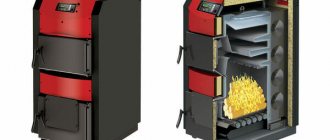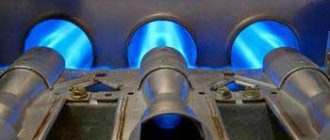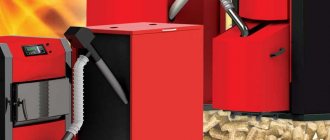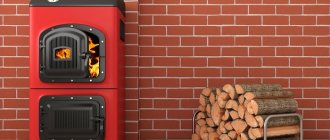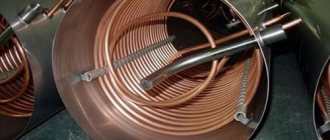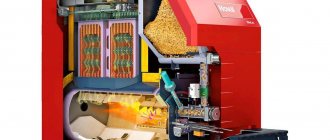Classification of solid fuels
Solid fuels are combustible substances, the main component of which is carbon.
Solid fuels include wood, peat, oil shale, coal and brown coal. The content of carbon, hydrogen, oxygen, nitrogen and sulfur, called chemical composition, determines the properties of solid fuels. When burned, equal amounts of different fuels release different amounts of heat. Then, to assess the calorific value of fuels, the largest amount of heat that can be released by the fuel during its complete combustion in the amount of 1 kg is determined. Coal has the highest calorie content.
Rice. 1. Some types of solid fuel
As is known from the course of thermal engineering, solid organic fuel is often used to produce heat and other types of energy with their subsequent conversion into mechanical energy. In addition, more than 300 different chemical compounds can be obtained from solid fuels with their appropriate distillation (processing).
Rice. 2. Wood is a solid fuel
Coal
Hard coal is coal with a high degree of charring and a gross calorific value of more than 24 MJ/kg (5700 kcal/kg) on an ash-free but wet basis and with a vitrinite reflectance of 0.5 or more.
Rice. 3. Coal
Hard coal includes non-sedimented sludge, not classified. The formation of coals mainly occurred in the Paleozoic, mainly in the Carboniferous period, which is more than 300 million years ago.
Like wood, the chemical composition of coal is a mixture of carbon, hydrogen, oxygen, nitrogen, sulfur, as well as water and volatile substances with small amounts of mineral impurities. Mineral impurities are not subject to combustion and form ash when burning coal. Each of the mined coals differs in the ratio of their constituent components, which also affects their calorific value. A number of organic compounds that make up coal have carcinogenic properties.
Rice. 4. Split piece of coal
For the formation of coal, abundant accumulation of plant matter is necessary. Since the Devonian period, organic matter accumulated in peat bogs, from which fossil coals were formed without oxygen. Most commercial fossil coal deposits date back to the Devonian period, although younger deposits also exist. The oldest coals are estimated to be about 350 million years old.
Coal was one of the first fossil fuels that began to be widely used by humans. The use of coal in industry for energy production has made it possible to take a big step forward. This coal was formed as a sedimentary rock due to the natural decomposition of ancient plants. Coal consists of a huge amount of carbon. The carbon content is several times higher compared to brown coals. In addition, coal contains volatile substances with a low ash content. The most effective alternative type of coal processing is its gasification. During gasification, carbon monoxide and hydrogen are produced from coal, then liquid fuel is produced using catalytic reactions. To obtain one ton of oil-like liquid, it is usually necessary to gasify 2-3 tons of coal. Also, coal is the main raw material for the production of graphite.
Industrially, sulfur, zinc, germanium, lead, and vanadium are extracted from coal. In the production of ceramics, building materials, and abrasives, waste from coal mining and processing, as well as ash remaining after their combustion, is used. In order for coal to be used rationally, mineral impurities are removed from it, that is, coal is enriched. Coke and coal are used in metallurgy in the process of iron smelting. In addition, coal is also used in metallurgy, in the production of steel and cast iron. Hard coal has the highest cost per ton of finished product. This is primarily due to its calorie content and low ash content. Also, coals are often used for heating houses.
We see that coal is used in almost all spheres of life. This circumstance suggests that coal mining will continue for a long time.
The prospects for the development of the coal mining industry around the world are not so clear. There is also no single doctrine for the processing of hard coal chosen by all countries. Strategies for the extraction and processing of coal are developed and adopted by each country individually and depend on the conditions, the level of profitability of the development of coal deposits, geological reserves, environmental restrictions, the place and role of coal in the fuel and energy balance, the degree of integration of the country's economy into regional and global structures and other.
Rice. 5. Coal mining
In a number of countries, due to favorable geological conditions for the exploitation of deposits, the coal industry is a highly profitable industry and serves as an important source of revenue for state budgets. We are talking about countries such as the USA, Australia, South Africa, Canada, Indonesia, Colombia. At the same time, there are many countries where the formerly developed coal mining industry, under the pressure of competition, was recognized as economically viable, as a result of which coal production was stopped, despite the significant increase in the dependence of most of these countries on external supplies of energy resources. This happened in Belgium, Holland, Ireland, Portugal, France, and Japan.
Solid fuel and its classification
Solid fuel and its classification
Origin of fuel. All types of solid fuel on our planet owe their origin to solar energy and chlorophyll - a special substance contained in leaves and other green parts of plants, which create complex organic substances and are later converted into fuel. In its transformations, the fuel substance successively passes through the stages of formation of peat, brown coal, hard coal, and anthracite.
In nature, there are various types of solid fuels, differing in their composition and properties. Solid fuel is mainly formed from highly organized plants - wood, leaves, pine needles, etc. Dead parts of highly organized plants are destroyed by fungi with free access of air and turn into peat - a loose, vague mass of humus, so-called humic acids. The accumulation of peat turns into a brown mass, and then into brown coal. Subsequently, under the influence of high pressure and elevated temperature, brown coals undergo subsequent transformations, turning into hard coals and then into anthracite.
Fuel composition. Fuel as it is extracted includes organic matter and ballast. The organic mass of fuel is considered to be that part that comes from organic substances: carbon, hydrogen, oxygen and nitrogen; ballast includes sulfur, mineral impurities - ash and fuel moisture:
С° + Н° + О° + N° + S°° = 100%, (12)
Solid fuel and liquid fuel consists of carbon C, hydrogen H, organic sulfur SO and combustible pyrite sulfur Sc, oxygen O and nitrogen N, which are in the form of complex compounds.
In addition to the indicated elements that make up the combustible mass of fuel, the fuel also contains ballast - ash A and moisture W:
B=Ar+Wр, (13)
Volatile, or flammable, sulfur is called
Sл= S° + Sk, (14)
Fuel composition is expressed as a percentage by weight.
In combustion technology, a distinction is made between working, dry and combustible masses of fuel. In this regard, when designating a substance included in the fuel, the letters p, s, or g are placed at the top. The working mass of the fuel is understood as the fuel in the form in which it is supplied to the consumer. The composition of the working fuel mass is expressed as follows:
Wed + Нр + Or + Np + S°p+ Spк + Ar + Wp = 100%, (15)
If we exclude ballast from the fuel, we get a combustible mass of fuel
Cg + Ng + Og + Ng + Sg° + Sgk = 100%, (16)
The dry mass of the fuel corresponds to dehydrated fuel and its composition is as follows:
Сс + Нс + Ос + Nc + Soс + Sск + Ac = 100%, (17)
Conversion of the fuel composition from one mass to another is carried out using coefficients (Table 7).
Table 7. Conversion factors for fuel composition from one mass to another
Example 1. Determine the composition of the working mass of fuel, the combustible mass content of which is equal to: Cr = 75.5%; Ng = 5.5%; Sgotk = 4.2%; Og= 13.2%; Ng = 1.6%; Ap= 18%; Wр = 13%.
We find the coefficient for recalculation according to the table. 7
100 — (18+ 13) / 100 = 0,69
Multiplying the elements of the combustible mass of the fuel by this coefficient, we obtain the composition of its working mass: Ср = 75.5 • 0.69 = 52.1%; Нр = 5.5 • 0.69 = 3.8%; Sро+к= 4.2 • 0.69 = 2.9%; Or = 13.2 •
0.69 = 9.1%; Np = 1.6 • 0.69 = 1.1%.
Carbon and hydrogen are the most valuable parts of the fuel.
Carbon is contained in significant quantities in fuels of all types: wood and peat 50-58%, brown and hard coals 65-80%, lean coals and anthracites 90-95%, shale 61-73%, fuel oil 84-87 % (figures are given as a percentage of the combustible mass of fuel). The more carbon there is in a fuel, the more heat it produces when burned.
The composition of the working mass of the fuel depends significantly on the size of the ballast, so most often data is given on the composition of the combustible mass of the fuel, which is more stable for fuel of each type and deposit.
Hydrogen is the second most important part of every fuel. In fuel, hydrogen is partially bound with oxygen, constituting the internal moisture of the fuel, as a result of which the thermal value of the fuel decreases. Hydrogen plays a large role in the formation of volatile substances released when fuel is heated without access to air. Volatile hydrogen is included in pure form and in the form of hydrocarbons and other organic compounds.
The hydrogen content as a percentage of the combustible mass of the fuel is: in firewood and peat up to 6, brown coal 3.8-5.8, oil shale up to 9.5, anthracite 2 and fuel oil 10.6-11.1.
The oxygen contained in the fuel is ballast. Not being a heat-generating element and binding fuel hydrogen, oxygen reduces the heat of combustion. The oxygen content in the organic mass of fuel decreases with age from 41% for wood to 2.2% for anthracite.
Nitrogen is also a ballast inert component of fuel, reducing the percentage of combustible elements in it. During fuel combustion, nitrogen in the combustion products is contained both in free form and in the form of NOx oxides. The latter belong to the harmful components of combustion products, the quantity of which should be limited.
Sulfur is contained in the fuel in the form of organic compounds S° and pyrite Sk, combined into volatile sulfur St. In addition, sulfur is included in the fuel in the form of sulfur salts - sulfates (for example, gypsum CaSO2), which are not capable of burning. Sulfate sulfur Sa is usually classified as fuel ash.
The presence of sulfur significantly reduces the quality of fuel, since sulfur dioxide gases SO2 and SO3 (combining with H2O to form H2SO4) destroy the metal of boiler equipment, entering the atmosphere, and have a harmful effect on living organisms and vegetation. Therefore, sulfur is an extremely undesirable element for fuel. Sulfur dioxide gases penetrating into work areas can cause poisoning to operating personnel.
Fuel ash is a ballast mixture of various mineral substances remaining after complete combustion of the entire combustible part of the fuel. Ash negatively affects the quality of fuel combustion.
There are three types of ash based on its origin: primary - internal, secondary and tertiary. Primary ash is formed from minerals contained in plants. Its content in the fuel is insignificant and the distribution is even. Secondary ash is obtained due to the introduction of plant residues by earth and sand during the period of formation. Tertiary ash enters the fuel during its extraction, storage or transportation.
Ash is an undesirable ballast of fuel, reducing the content of other combustible elements in it. In addition, ash, forming deposits on the heating surfaces of the boiler unit, reduces heat transfer from gases to water, steam and air in its elements. The presence of a large amount of ash makes the operation of the boiler difficult. If the ash is fusible, it sticks to the heating surface of the boiler, disrupting its normal operation (slaging).
The ash content as a percentage of the working weight of the fuel is: in firewood 0.6, in peat 5-7, in brown and hard coals from 4 to 25, in fuel oil 0.3.
When burning solid fuels, the characteristics of the ash and the degree of its fusibility are important. The fusibility of the ash is determined in the laboratory. Several “cones” made of ash, 20 mm high with a base side of 7 mm, are placed in a special electric furnace. One of the faces of the pyramid must be perpendicular to the base.
During the process of gradual heating of the pyramids in an electric furnace, three points are noted (Fig. 8): the temperature of the onset of deformation t1, determined at the beginning of melting of the top of the pyramid; softening temperature t2, which is fixed at the moment when the top of the pyramid tilts to the base or the pyramid turns into a ball, and temperature t3, when the contents of the pyramid spread over the base.
Ash can be low-melting with a softening point below 1050°C, causing slagging of the furnace when burning fuel, and refractory with a softening temperature above 1050°C.
Considering the great influence of ash content on the quality characteristics of fuel, the concept of reduced ash content is used for comparative calculations
ArP=Ar/Qrn, (18)
where Qrn is the working lower heat of combustion of fuel, MJ/kg.
Fuel moisture consists of external, or mechanical, caused by surface moistening of pieces of fuel and filling of pores and capillaries with moisture, and equilibrium, called hygroscopic, which is established in the material during prolonged contact with the surrounding air. The content of external moisture is determined by drying a fuel sample in air to constant weight, and the hygroscopic Wg of solid fuel is determined by drying a crushed sample of air-dry fuel in a drying cabinet to constant weight at 102-105°C.
To determine the moisture content of liquid fuel, water is left to settle for 24 hours at 40°C in special vessels and the entire Sample and water are weighed. When the moisture content of the gaseous fuel is determined, a gas sample is passed through a layer of calcium chloride that absorbs moisture.
Rice. 8. The nature of deformation of a laboratory sample of solid fuel ash when determining its fusibility
In combustion technology, the concept of reduced humidity is used, which shows how much moisture as a percentage of the working mass of the fuel is per 1 MJ of lower calorific value.
Wrn = Wp/Qrn, (19)
Volatile substances and coke. To assess fuel quality and combustion conditions, the yield of volatile substances is of great importance. If you heat fuel without access to air, then under the influence of high temperature (from 200 to 800 ° C) it decomposes into a gaseous part - volatile substances (hydrogen, methane, heavy hydrocarbons, carbon monoxide, some carbon dioxide and some other gases, i.e. e. mainly gaseous flammable substances) and a solid residue - coke. The volatile yield is related to the combustible mass of the fuel and is designated Yg%.
The yield of volatile substances, their composition, as well as the temperature at which they begin to be released are determined by the chemical age of the fuel: the older the fuel, the lower the yield of volatiles and the higher the temperature at which their release begins. For example, the yield of volatile peat is approximately 70% of the total mass of the combustible part of the fuel; they begin to be released at 120-150°C; the yield of volatile brown and young hard coals decreases from approximately 13 to 58.5%, they begin to be released at 170-250°C, and anthracite - up to 4% at a temperature of the onset of gas evolution of about 400°C.
Volatile substances have a great influence on the combustion process of fuel: the higher the yield of volatiles, the lower the ignition temperature and the easier the ignition of the fuel and the larger the surface of the flame front. Solid fuel with a high yield of volatiles (peat, brown coal, young coal) ignites easily and burns quickly with little heat loss. Fuel with a low volatile yield, such as anthracite, is much more difficult to ignite, burns more slowly and does not burn completely.
The coke remaining after the complete release of volatiles consists of carbon and mineral fuel impurities. Depending on the type of thermally decomposed fuel, coke can be powdery, sticky, sintered, or fused.
Heat of combustion of fuel. The most important characteristic of fuel is the calorific value, which is the amount of heat obtained by burning 1 kg of solid or liquid fuel or 1 nm3 of gaseous fuel in kJ/kg (kcal/kg): 1 kcal - 4.1868, or 4.19, kJ .
As mentioned earlier, combustible elements in fuel include carbon C, hydrogen H and volatile combustible sulfur Sl. Elementarily, their combustion can be represented by the following equations:
C + O2 = CO2; 2H2 + O2 = 2H2O; S + O2 = SO2, (20)
During the combustion of combustible elements, the following amount of heat is released when burning 1 kg: carbon - 33.65 MJ (8031 kcal/kg), sulfur - 9 MJ (2172 kcal/kg), hydrogen - 141.5 MJ (33770 kcal/kg) .
There are higher and lower calorific values. The higher calorific value (Qрв) of a fuel is the total amount of heat released during the combustion of 1 kg of solid or liquid fuel, or 1 nm3 of gaseous fuel (under normal conditions) and the transformation of water vapor contained in the combustion products into liquid. In practice, however, it is not possible to cool the combustion products until complete condensation, and therefore the concept of lower calorific value (Qrn) has been introduced, which is obtained by subtracting from the higher calorific value the heat of vaporization of water vapor both contained in the fuel and those formed during its combustion. The vaporization of 1 kg of water vapor requires 2514 kJ/kg (600 kcal/kg). For solid and liquid fuels, lower calorific value (kJ/kg or kcal/kg)
Qpн = Qрв-2514 (9Нр+Wр/100), (21)
Qpн = Qрв – 600 (9Нр+Wр/100)
where 2514 is the heat of vaporization at a temperature of 0°C and atmospheric pressure, kJ/kg; Нр and Wp - content of hydrogen and water vapor in the working fuel, %; 9 is a coefficient showing that the combustion of 1 kg of hydrogen in combination with oxygen produces 9 kg of water.
If the elemental composition of the fuel is known, then the lower calorific value of solid and liquid fuel, kJ/kg or kcal/kg, can be determined using the empirical formula proposed by D. I. Mendeleev:
Qpн = 339.5Ср + 1256Нр - 109 (Or - Spl) - 25.14 (9Нр + Wp)
or
Qpн = 81Ср + 246Нр - 26 (Or - Sрл) - 6Wр, (22)
Example 2. Determine the lower calorific value of fuel, the working mass of which has the following composition (from example 1): Ср = 52.1%; Нр = 3.8; Sрл = 2.9%; Np = 1.1%; Or = 9.1%; Ap = 18%; Wp = 13%.
Substituting the data into formula (22), we obtain Qpн = 339.5 • 52.1 + 1256 • 3.8 - 109 • (9.1 - 2.9) - 25.14 • (9 • 3.8 + 13) = 20.647 MJ/kg or Qpн = 81 • 52.1 4- 246 • 3.8 - 26 • (9.1 - 2.9) - 6 • 13
= 4916 kcal/kg.
The numerical coefficients in this formula were selected experimentally. The heat of combustion of solid and liquid fuels can also be determined experimentally, using a calorimetric method. The heat of combustion of working fuel is determined in a calorimeter (Fig. 9), which consists of a calorimetric vessel 5 filled with water, a calorimetric bomb 2 with a cup for weighing fuel, a shell 6, a thermometer 4, a double lens 3, an electric motor vibrator, a propeller mixer 1 for mixing water in the shell and stand 7. To find the heat of combustion of the fuel, place a sample of the fuel in a cup and burn it, and the test results are determined by the readings of the thermometer.
For the convenience of comparative calculations when burning different types of fuel in boiler houses, the concept of “standard fuel” has been introduced. Conventional fuel is considered to be the fuel whose calorific value is 29.35 MJ/kg (7000 kcal/kg). Conversion of natural fuel consumption into conventional fuel, kg, is carried out according to the formula
Vusl=VnQpn/29.35 (Vusl=VnQpn/7000, (23)
Rice. 9. Diagram of a calorimeter for determining the specific heat of combustion of coals
It is always convenient to express production targets and fuel reporting data in standard fuel.
Example 3. Ext. is burned in a boiler room for a month. month = 200 tons of fuel with calorific value Qrn = 20.647 MJ/kg (Qrn = 4916 kcal/kg).
Determine the annual consumption of equivalent fuel.
Equivalent fuel consumption
Vusl.month=200•Qpn/29.35=200•20.647/29.35=140
(Vusl.month=200•Qpn/7000=200•4916/7000=140)
Vusl.year = 140•12=1680
Solid fuel and its classification. Based on chemical age, three stages of solid fuel formation are distinguished: peat, lignite and coal. Wood is a fuel used primarily in small boiler installations. Wood processing waste is widely used: slabs, chips, shavings, sawdust, bark, etc. Firewood is used less frequently.
The humidity of air-dry firewood does not exceed 25%, semi-dry - 35%, freshly cut - 50%. Sawdust usually has a moisture content of 45-60%. Semi-dry firewood includes spring-harvested firewood that has lain for at least 6 months after cutting, including at least two summer months. Dry firewood includes firewood that has lain in the forest for about a year after cutting and whose humidity does not exceed 30%.
Firewood as a solid fuel is characterized by a high yield of volatile combustible substances - up to 85% and an insignificant ash content - on average up to 1%, only in alloy firewood the ash content increases to 5%. Consequently, the ballast of firewood is determined mainly by its humidity, on which the heat of combustion depends. The heat of combustion depends little on the type of firewood, as can be seen from the table. 8.
Table 8. Organic composition of wood
The working composition and calorific value of wood waste (chips, sawdust, etc.) do not differ from the composition of the wood from which they are obtained.
With a reduced calorific value, firewood has advantages: easy flammability, lack of sulfur and low ash content, which allows us to limit ourselves to simple combustion devices that work efficiently.
Based on the extraction method, peat is divided into three main types: machine-molded (bagger), hydraulic and milling.
With the machine-molding method, the peat mass is taken from the peat quarry by excavators (baggers) and fed to special presses, where it receives the form of a tape, which is cut into individual bricks, and then they are mechanically distributed by conveyors over the drying field, and then stacked.
The hydraulic method of peat extraction is based on washing out the peat mass with a stream of water flowing under strong pressure. The resulting slurry - pulp is passed through special grinders, pumped to the site, where it is dried. The dried peat mass is cut into bricks using special machines.
The milling method means that the peat bog is gradually developed - plowed with special machines to a depth of 5 to 35 mm. The resulting peat chips are dried and then stacked.
Peat as a fuel is similar in properties to firewood. Peat moisture content varies depending on the extraction method, drying and storage conditions from 30-40 to 50-55%. The humidity of milled peat is approximately 5-10% higher than that of lump peat. The ash content of peat (Ap) extracted in the central regions of Russia ranges from 7 to 15%. Heat of combustion Qpн = 8.38 - 10.72 MJ/kg (Qpн = 3511 - 4492 kcal/kg).
Fossil coals are divided into brown, hard and anthracite.
When classifying, coals are distinguished by grade, class and group, as well as by composition, size, and ash content. The brands differ from one another in the release of volatiles and the degree of sintering. Coal groups are determined by their ash content. Based on the size of the pieces, fossil coals are divided into classes.
Brown coal contains a lot of moisture, easily combines with oxygen in the air, and when stored in air for a long time, it strongly erodes and crumbles into powder. In addition, it has a high tendency to spontaneous combustion. Its structure is characterized by a high ballast content and unusually high hygroscopicity, as a result of which the moisture content of brown coals is Wp = 17-55%. Brown coals do not sinter, they are distinguished by a high yield of volatiles (Vg = 33.5 - 58.5%) per combustible mass and ash content per dry mass (Ac = 10.5 - 34%), high sulfur content (Sn = 0.6 - 5.9%). Working heat of combustion Qpн = 10.7 - 17.5 MJ/kg (4177 kdal/kg).
Hard coal in Russia is available in huge quantities and is divided into: long-flame, gas, steam-fat, coke-steam sintering and lean. Hard coals have a high calorific value Qpн = 21.20 - 28.07 MJ/kg (5097 - 6700 kcal/kg). Volatile yield Vg = 3.5 - 45%. Coal is used directly as fuel or processed into coke. Based on the type of coke, a distinction is made between non-caking coals (powdered coke) and caking coals (fused coke, sometimes expanded). Hard coals are quite dense and low-porous, and their external moisture content is significantly lower than in brown coals. Many coals have increased mechanical strength. They are more stable in storage, less susceptible to spontaneous combustion, and some types do not spontaneously combust at all.
Anthracite is one of the oldest coals in origin, it is very hard, difficult to ignite, burns with a short flame, and withstands overload and transportation well.
These include coals with a volatile content of the combustible mass Vr = 2 - 9% and a heat of combustion of the combustible mass Qpн = 24.35 - 27.24 MJ/kg (5800-6500 kcal/kg). The transition between hard coals and anthracite is semi-anthracite. Anthracite and semi-anthracite do not spontaneously combust. Characteristics of solid fuel for energy purposes are given in Table. 9. Brands of coal differ from one another in the yield of volatiles and the degree of sintering. The following grades of coal are distinguished: D (long-flame), G (gas), Zh (fat), KZh (coke-fat), K (coke), S (lean, caking), T (lean), SS (low-caking). All types of coals are divided into classes according to the size of the pieces (Table 10). Oil shale is a product of the decomposition of plant residues deposited at the bottom of large bodies of water; mixing with mineral sediments, a silty substance was formed - sapropel, which was enriched with hydrogen, compacted and turned into oil shale.
Shales have a calorific value of Qpн = 10.38 MJ/kg (2477 kcal/kg); when burned, a very large amount of ash is formed, Ac = 64.5%. The volatile yield of shale is very high: Vr = 90%, humidity Wp = 13%. Shale is a local fuel.
Table 9. Characteristics of solid and liquid fuels
The first term is ash, the second is carbon dioxide (mineral).
In Fig. Figure 10 shows a diagram of the composition of the working mass of various types of fuel.
Rice. 10. Diagram of the composition of the working mass of various types of fuel
Continuation of table 9
Table 10. Classification of coals by size of pieces
Brown coal or lignite
Brown coal or lignite is coal with a low degree of charring that has retained the anatomical structure of the plant matter from which it was formed. This coal has a gross calorific value of less than 24 MJ/kg (5700 kcal/kg) on an ash-free, wet basis. Its vitrinite reflectance is less than 0.5.
Subbitominous coal, or brown coal, is a combustible mineral, fossil coal of the 2nd stage of metamorphism (a transitional link between lignite and hard coal), obtained from lignite or directly from peat.
Rice. 6. A ten-ton lump of lignite at the Lignite Museum in Japan
The classification of fossil coals is quite confusing, for example, in England and the European Union they use the term lignite (which is considered synonymous with brown coal), and in America the concepts of brown coal and lignite are distinguished separately and very clearly. In Russia, a synonym for brown coal is lignite. Basically, this type of coal is called brown coal; lignite with a high degree of carbonization (HCC) also belongs to this category, and without taking into account subbituminous coals with a high degree of carbonization, the latter coals are already classified as hard coal.
Rice. 7. The most typical appearance of brown coal
The use of brown coal in Russia and many other countries for large-scale energy as a fuel is significantly inferior to the use of hard coal. However, its low cost makes it attractive for combustion in small and private boiler houses, where the share of its use averages up to 80%. Brown coal is burned in pulverized (during storage, brown coal dries out and crumbles) and lump forms in a layer. The main energy fuel at thermal power plants in Greece and especially Germany is brown coal to generate electricity. So in Greece, up to 50% of electricity is generated at such stations, 24.6% in Germany.
The production of liquid hydrocarbon fuels from brown coal through distillation is also gaining momentum. After distillation, the residue is suitable for producing soot. Combustible gas is extracted from it, and carbon-alkali reagents and montan wax (mountain wax) are obtained. Montan wax is used in small quantities to make crafts.
If we talk about the stability of the market for thermal coal, it is quite stable. In this connection, an increase in the sales volume of brown is hardly expected. Along with the stable situation in the energy sector, there was a shortage of metallurgical fuels and coke products. And therefore, now many resources are aimed at developing technologies for processing brown coals into a finished product for the needs of metallurgy. Such processing will be economically justified in the future, because the cost of coke products is several times more expensive than ordinary coal.
Rice. 8. Installation that generates electricity from brown coal
In the world, two enterprises have been carbonizing brown coals for many years: the Rheinbraunkole plant with a capacity of 210 thousand tons/year of coke in Germany and a capacity of 80 thousand tons/year. Technologies developed in the 30s of the last century and then improved are characterized by extremely high capital intensity. This aspect makes it impossible to purchase imported technologies and equipment.
In Russia, a fairly large number of scientific teams are working on this topic; there are also technological developments on the topic of thermal upgrading of brown coal. But in most cases, these studies are performed only at the laboratory level
installations. It is known that only 5% of all developments go from laboratory installation to commercial enterprise with reliable technology. This is due to large investments and a long testing period, the return from which will not return very soon.
Fuel for solid fuel heating boilers
Various types of fuel were tested in the universal solid fuel boiler Stropuva. The purpose of the tests is to help the consumer choose a fuel based on its price or ease of use. Universal boiler S40. Old built house. In residential premises with an area of 135 m2, the temperature was maintained at 22–23°C, in workshops with an area of 40 m2 – 8–12°C. During the test, the house spent 133 - 162 kW/h of heat per day. Therefore, the boiler operated in low mode - 10–15% of its normal power. Fuel purchased directly from suppliers was weighed and put into the boiler without sorting, sorting, without deducting fuel moisture, without assessing the efficiency of the boiler, so the calorie content will differ from that declared by suppliers. For similar reasons, the amount of fuel in the firebox is also approximate. For example, more kilograms of coal loaded from the street will fit into the firebox than dry coal from a warehouse.
Alder firewood.
1 kg in the boiler releases 2.86 kW/h of heat (2460 kcal). Fits in S40 - 70kg, S20 - 50kg, S10 - 25kg, S7 - 15kg). The firewood was in the attic for 16 months, large, a lot of unsplit logs 15 - 25 cm.
Spruce shavings, small.
1kg – 3.2kWh (2750kcal) Fits in S40 – 66kg, S20 – 48, S10 – 24kg, S7 – 14kg.) Chips were crushed 10 months ago.
Black alder briquettes.
1kg – 3.49 kW/h (3000kcal) Fits in S40 – 170kg, S20 -100kg, S10 – 50kg, S7 – 30kg. The briquettes are large, the size of a beer glass. Burns well with a slot diffuser designed for firewood.
Briquettes of hardwood.
1kg – 3.1 kW/h (2670kcal) Fits in S40 – 175kg, S20 – 110kg, S10 – 55kg, S7 – 33kg. Lump briquettes the size of a computer mouse, predominantly maple. They burned unsteadily. It is recommended to use a blower and a tube diffuser designed for coal. Despite the fact that the volume of hardwood produces more energy, the weight is less than that of light wood (spruce, aspen...), so if hardwood firewood (m2) is more expensive, then hardwood briquettes sold by weight (kg) should be cheaper light wood briquettes. When heating with any wood fuel, the ash should be removed every 10-30 days. Once the wood has flared up, it emits little smoke, but while it is burning, the smoke is thicker. Therefore, it is not recommended to complete the loading with small firewood; on the contrary, larger logs should be placed under the edges of the distributor, and 0.2 - 0.5 kg of small kindling in the middle is sufficient.
Briquettes of Lithuanian peat.
1 kg – 2.26 kW/h (2000 kcal) Placed in a universal boiler s40 – 175 kg, s20 – 110 kg, s10 – 55 kg. Lithuanian peat should be burned without bottom air, but with a blower and a tubular diffuser. At the end, for the fastest end of combustion, you should open the air from below. Lithuanian peat contains half as much ash as Belarusian peat, but it doesn’t hurt to clean it before each load.
Briquettes of Belarusian peat.
1 kg – 2.36 kW/h (2290 kcal) Placed in a universal boiler s40 – 190 kg, s20 – 119 kg, s10 – 90 kg. Belarusian peat should be burned with bottom air supply, using a blower and a tubular diffuser. Belarusian peat contains a lot of ash, fused slags are formed. Ash should be removed before each load. When heating with peat, a lot of solid particles are released from the chimney, and a sour smell is felt, so it is not recommended to heat with peat in densely populated areas.
Hard coal DPK.
1 kg – 4.85 kW/h (4170 kcal) Fits in a universal boiler s40 – 210 kg, s20 – 140 kg, s10 – 65 kg. Like the above-mentioned types of fuel, coal is heated from above by loading about 5 kg of firewood. Open the air supply from below and use a tubular diffuser. Each time a bookmark burns out, the ashes should be removed. Coal is a more expensive fuel, but easier to use: the s20 boiler emits 680 kW/h, which is enough energy for a house with a daily requirement of 150 kW/h, enough for 4 days.
Coal SSOM.
1 kg – 5.59 kW/h (4810 kcal) Placed in a universal boiler s40 – 230 kg, s20 – 145 kg, s10 – 70 kg. This coal is even more calorific and more expensive. But, despite the fact that we pay more, kcal costs the same as when using the above-mentioned coal. The heating features are the same as when using WPC coal. While it flares up, the coal smokes a little for half a day.
Fine anthracite AM.
1 kg – 5.68 kW/h (4875 kcal) Fits in a universal boiler s40 – 270 kg, s20 – 170 kg, s10 – 85 kg. Anthracite burns with difficulty, but burns with a hot flame without smoke, so no smoke is visible from the chimney, and for this reason it is convenient to heat in populated areas. Anthracite should be loaded to the bottom of the upper door, about 10 kg of firewood should be placed on top. When the wood burns well (turns into burning coals), load another 15 - 40 kg of anthracite on top of it and lower the tubular diffuser. Don't panic that the temperature in the heating system will drop for an hour or two. Do not mix the fuel under any circumstances - this will lead to extinguishing. To burn anthracite, a more massive combustion center is required than for other types of fuel, so about 15 - 30 kg of it does not burn - it is necessary to return it to the next stash when removing the ash. For this reason, boilers with large fuel tanks are more convenient for heating with anthracite, while large anthracite is more suitable for heating.
Large anthracite AKO.
1kg – 5.72kWh (4920kcal) Fits in s40 – 280kg, s20 – 175kg, s10 – 88kg. The properties and method of ignition are the same as when using fine anthracite. If these recommendations are followed, the boiler parts will last a long time, since they will not be affected by the high temperature that this type of fuel develops.
When choosing fuel, knowing the offered prices and how much energy each fuel emits in the boiler, you can calculate the price per unit of energy
, for example: 1 kW/h of anthracite will cost: the proposed price for 1 kg is 5 rubles. : 5.72 kW/h = 0.87 rub. According to the energy passport of the house or if there is a heat meter in the system, you will know the heat demand of your house, for example: For a season 25000 kW/h - calculate the price of heating and the amount of fuel for the season: 25000 kW/h anthracite: 5.72 kW/h = 4.37t of fuel • 5000 rub. = 21850 rub. How long will one bookmark burn? Laying 25 kg of firewood X 2.86 kW/h: the heat demand of the house per day is 70 kW/h = 1 day.
We recommend:
Simple automatic boiler selection service
For those who have not decided on the choice of a solid fuel boiler, we recommend reading the review article “Solid fuel boilers - new generation heating boilers.” And also “Solid fuel boilers for long burning - modern heating of private houses.”
Peat
Peat (German: Torf) is a combustible mineral; formed by the accumulation of moss remains that have undergone incomplete decomposition in swamp conditions. A swamp is characterized by the deposition on the soil surface of incompletely decomposed organic matter, which later turns into peat. The peat layer in swamps is at least 30 cm (if less, then these are wetlands).
Rice. 9. Peat medium-decomposed horizon of sod-podzolic soil-gleyed soil
Peat differs from soil formations in the content of organic compounds; their amount in peat is at least 50% in relation to the absolutely dry mass. In 30-50 years. In the last century, peat was actively used in the energy sector and for gas production, as well as for heating houses.
The use of peat as a fuel is due to its composition: high carbon content, low sulfur content, harmful non-combustible residues and impurities. Essentially, it is young coal.
The main disadvantages of peat are its low calorific value, as well as the difficulty of burning it, which is due to its high moisture content (up to 65%).
The advantages of peat fuel are:
- environmentally friendly combustion (low sulfur content);
- complete combustion (small ash residue);
- low production costs;
- new combustion technologies have emerged.
Rice. 10. Peat in hand
During the marketing research “Russian market of organic fertilizers: results of 2011, forecast for 2012-2013”, conducted by NeoAnalytics, it turned out that the production of peat for agriculture has great prospects. This can be characterized by the fact that the peat industry has declined. Thus, in the period from 1990 to 2011, peat production decreased by more than 20 times, most enterprises associated with the extraction and processing of peat ceased operations, and at other currently operating enterprises, the equipment was physically and morally obsolete. Previously developed peat deposits are overgrown, which increases the cost of peat extraction, or are returned to the state forest fund as unused.
Rice. 11. Properties and applications of peat
Rice. 12. Peat extraction
If we compare peat production indicators, it is easy to notice its decline. Thus, in 2011, 128 thousand tons of peat for agriculture were produced, which is almost 30 times less than production in 1998 (3834 thousand tons). Peat reserves by economic regions of Russia are distributed as follows: more than half of the peat reserves (51%) are located in the West Siberian region, followed by the Northern region in second place (18%), and the Far Eastern region in third place (13%). The smallest peat reserves are located in the Central Economic Region, about 2%.
Peat is considered a renewable natural resource.
It is used mainly in energy and agriculture.
More than 65% of the extracted peat is supplied for agricultural needs. In general, peat resources on a global scale are estimated at more than 400 million hectares. Of these, 162.7 billion tons with a humidity of 40% are located on the territory of the Russian Federation.
Rice. 13. Peat in agriculture
Briquette fuel
Briquette fuel is another purpose of coal briquettes. Briquetting occurs by sintering coal or peat particles, under the influence of temperature and pressure, into briquettes of the correct shape. For better sintering of coal particles, binders are added to coal briquettes during their production.
Peat briquettes are a ready-to-burn product made from raw peat with or without the addition of binders, followed by drying and high-pressure treatment.
Rice. 14. Peat fuel briquettes
Brown coal briquettes are made from brown coal and lignite. They are sintered under high pressure without adding binders after preliminary crushing and drying to form briquettes of the correct shape.
What types of fuel currently exist?
Heating apartments and houses with boilers is popular, so there are enough fuel options to choose the best one. The choice of raw materials often depends on the model of the unit. Fuel types:
- wood. You can prepare firewood yourself, purchase ready-made beams for ignition;
Firewood for the boiler
When buying firewood with a reserve, you need to equip a place for proper storage of fuel. The space should limit the entry of dampness.
- coal. Raw materials are economical and heat the room for a long time. The fuel price is affordable, the burning time is long;
Charcoal for ignition
- pellets, wood briquettes. The price is quite high, but the material provides a long burning period;
Pellets for heating
- peat briquettes. Raw materials are expensive. However, the price justifies the quality. Peat briquettes have a high efficiency, so consumption is minimal;
Briquettes for heating
- coke. Provides long burning, due to which the room temperature is comfortable.
Types of fuel
Each type of fuel has pros and cons.
When purchasing raw materials, you need to consider which type is suitable for a particular device.
Coke
Coke is a solid residue obtained by dry distillation of coal or lignite in the complete absence of air access (carbonization).
There are coal coke, lignite coke and gas coke.
6.1 Coal coke
Coal coke (from German Koks and English coke) is a solid, gray, porous product obtained by coking coal at temperatures of 950-1100 °C without air access. Coke contains 96-98% C, the rest H, S, N, O. Porosity 49-53%, true density 1.80-1.95 g/cm³, apparent density ≈ 1 g/cm³, bulk weight 400-500 kg /m³, ash content 9-12%, volatile matter yield 1%. Humidity when extinguishing with water and inert gas is 2-4% and no more than 0.5%, respectively. Ultimate compressive strength 15-25 MPa, shear strength (characterizes abrasion resistance) 6-12 MPa, calorific value 29-30 MJ/kg.
Rice. 15. Coal coke
For the smelting of cast iron, coal coke is mainly used as a high-quality smokeless fuel or blast furnace coke in other words; it is also used as a reducing agent for iron ore and a disintegrant for charge materials. Coal coke is also used as cupola fuel in foundries (foundry coke), for domestic purposes (household coke), and in the chemical and ferroalloy industries (special types of coke).
Blast furnace coke is produced with a piece size of at least 25-40 mm, the presence of fines should be no more than 3% (pieces up to 25 mm and no more than 2-3% for pieces larger than 80 mm.
Foundry coke, if we consider it by the size of the pieces, it turns out that it is larger than blast furnace coke. It is also more suitable as a product containing pieces smaller than 60-80 mm. The main difference between foundry coke and blast coke is that it contains very little sulfur, less than 1% versus 2% in blast furnace coke.
In the production of ferroalloys, coke of fine fractions of the order of 10-25 mm is actively used. The cokes used have a high degree of reactivity. If we talk about the strength of coke, these requirements are less stringent than, for example, for blast furnace or foundry coke.
Rice. 16. Domain process
The best coke for any type of production is strong, low-ash coke with low sulfur content and a small amount of fines.
In the modern world, the production of coal coke is about 550-650 million tons/year. More than half of this volume is produced in China (60-70% of world production).
6.2 Gas coke
Gas coke is a by-product of coal processing, used to produce artificial gas in gas plants, and furnace coke, which includes all other types of coke obtained from coal.
6.3 Lignite coke
Lignite coke is a solid product obtained by carbonization of lignite briquettes.
Rice. 17. Coal particles in lignite coke
Today, the main consumers of lignite coke are ferrous and non-ferrous metallurgy. Here it is used as a reducing agent or process fuel for agglomeration and the production of ferroalloys, as a waste additive in the production of metallurgical coke and the main filler in the production of coke briquettes. The produced coke-coal briquettes are used as household fuel. The main fillers of such coke are heavy or total tar and semi-coke. Semi-cokes are also actively used for their gasification to produce combustible gas and in some chemical industries.
Wood commodity forms
As an alternative to natural raw materials, Euro firewood has been developed and produced. They are pressed into a trunk or brick from waste from the woodworking industry, food production and agricultural industries. To form them, steaming followed by pressing is used. Most often, no binding additives are used, but the particles are glued together with lignin, a polymer of natural origin.
Pini-kei tiles
They are produced in the form of a log with a hexagon-shaped end. A longitudinal groove runs along the length. A high density of the product (1.1-1.4 g/cm³) is obtained during pressing on screw units under pressure. The technological groove on the surface enhances combustion, the passage of air flow when stored in the firebox, and increases the smoldering area.
The dark color is given to the briquette during heat treatment (heating up to 200°C), due to which the products become resistant to moisture. The Nestro brand of product is manufactured on mechanical presses that operate using the impact method, which creates a pressure of 450-650 bar. The density of the products is lower than usual (0.95-1.25 g/cm³). Cylinders are sold without a side groove, but sometimes it is present.
Products for Ruf boilers
The fuel material produced under this brand is distinguished by its brick-shaped form. It is made by pressing using hydraulic equipment, which creates a pressure of 350-450 bar. The density of the stones is 0.73-0.85 g/cm³, the raw materials are wood and its waste.
Due to their greater hardness (compared to firewood) and dry state (4.5-6% moisture), briquettes emit 3750 kcal of heat when burning, which is more than the average of any wood. The final physical properties of the product are influenced by the choice of starting material. For production, deciduous and coniferous trunks or plant residues of other organic matter are used.
Products that use sunflower seed husks provide a lot of heat. Briquettes burn without residue, there is little ash. The chemical composition of the raw material contains oil, which increases the temperature in the firebox. There is also a downside - the smoke channel becomes contaminated with soot.
Sawdust material
Briquettes made from waste during planing are in second place in terms of the volume of heat generated and are comparable to wooden blocks. When choosing a material for a furnace, the calorific value of the raw material is taken into account. Compared to heating briquettes made from rice husks, which produce 21% ash, sawdust produces only 2.6%.
When purchasing, pay attention to the dimensions of the product. High-quality samples are produced with a thickness of 6-8 cm, and the length of the element does not exceed 35 cm. Reducing the size leads to cheaper material; such bars are produced in 4-6 cm by 5-15 cm. These parameters are associated with the loose body of the log, which will disintegrate when increased dimensions
The production of briquettes pursues the goal of preserving forests and is, in this sense, the preferred type of fuel. Briquettes are made from buckwheat, seed husks, tyrsa, sawdust, shavings, corn stalks, and hay. In this case, whole trunks are not used in the work.
The positive point is the ideal shape, as a result of which the briquettes are placed compactly in the mouth and allow you not to look into the firebox for a long time. This is important when operating gas generator boilers that burn additionally released combustion products.
Pellets - granules for stoves
Products are produced in diameters up to 8 mm, their length is 5 cm. This is a common fuel for pellet boilers used in many countries around the world. The raw materials are straw, bird droppings, wood waste.
The mass is crushed and ground into fine crumbs, then goes to a granular press for compression and shaping. Products after processing are characterized by increased density and reduced humidity. There are dark-colored granules on sale that are exposed to high temperatures. Their performance has been improved; this material is called biochar. Granules are distinguished by grade:
- Standard dark in color due to the raw material base (buckwheat husks and seeds). After combustion, 3% ash is formed. The optimal type of fuel at an affordable price with sufficient heating.
- Premium granules. Gray or white with high heat generation and ash residue after decomposition (0.4%).
- Industrial. Used in industrial ovens. These dirty gray products are made from wood waste containing bark. They are characterized by low cost.
To use pellets for heating, special boilers are installed, which have a firebox and a bunker. The technological burner of such furnaces allows them to approach the performance of gas boiler models.
Oil shale
Oil shale is a sedimentary rock high in organic matter (kerogen) that can be converted into crude oil or gas by heating.
Oil shale is a mineral from the group of solid caustobiolites, which during dry distillation produces a significant amount of resin (close in composition to oil). The formation of shales mainly occurred 450 million years ago on the seabed from plant and animal remains.
Oil shale consists of predominant mineral (kaolinite, calcite, montmorillonite, quartz, feldspars, dolomite, hydromica, pyrite, etc.) and organic parts (kerogen), the latter making up 10-30% of the rock mass and only in shale of the highest quality reaches 50-70%. The organic part is a bio- and geochemically transformed substance of protozoan algae that has retained its cellular structure (thallomoalginite) or lost it (colloalginite); As an impurity, the organic part contains altered remains of higher plants (vitrinite, fusainite, lipoidinite).
Rice. 18. Kukersite (oil shale).
Oil shale is a rock of mixed clastic and organic origin; are formed at the bottom of seas, lagoons, lakes with the simultaneous deposition of clay particles, carbonate matter and sapropelic silt with organic residues (plankton, higher plants) under conditions of limited circulation of water and air. The accumulated organic-mineral mass gradually compacts and transforms into dense sedimentary rock.
Oil shale has established itself primarily as a very valuable energy raw material. They are used as fuel, as well as in various industries: the chemical industry, agriculture and road construction, in the energy sector, and in the production of building materials. Shale resin is of particular value. It is used as a raw material for the production of liquid fuel, as well as various valuable chemical products (drying oil, sulfur, pesticides, paints). Synthetic oil is also sometimes produced from oil shale. They also contain significant concentrations of radioactive and rare earth elements.
These rocks are divided, in particular, into combustible, clayey and crystalline. The daily range of uses for shale is very large. For example, slate rocks are used for the production of fire-resistant raw materials, in construction for exterior decoration, and the well-known tiles also belong to the same rock.
Shale gas is extracted from rocks located at great depths. Basically, such gas is stored in shale, which has a porous structure. The gas content in shale is small and it is stored there in small portions in the industrial sense. Thus, when gas is pumped out of shale rocks, many impurities are introduced into it. Today, the methane content in produced gas varies from 30 to 70%. This circumstance indicates the need to purify the gas in the already complex process of gas production. Therefore, in order to produce inexpensive, but at the same time clean gas, they are trying to develop gas deposits shaped like bubbles.
According to the international energy agency IEA and the independent energy consulting company ARI, as of June 2013, the largest reserves of shale gas are located in the United States - about 32.875 billion cubic meters. China is in second place - according to experts, 31.573 billion cubic meters are concentrated there. In Europe, significant reserves of shale gas have been discovered in Austria, Great Britain, Hungary, Germany, Sweden, Ukraine and Poland. Russia ranks only 9th in this ranking, but is by far the leader in the list of shale oil owners.
Rice. 19. Shale gas production scheme
Today, shale gas production has been banned in a number of European countries by introducing a moratorium. This is due to concern for the environment. Russia also stated that it does not intend to begin developing shale gas in the coming decades. The United States, on the contrary, has been producing shale gas for several years now. World shale gas reserves are currently estimated at 220.729 billion cubic meters.
Tar sands
Tar sands are sands or sandstones (bitumens) with a high content of resinous carbons that are capable of releasing oil when heated or other extraction processes.
Tar sands also include other types of crude oil, as well as thick, viscous petroleum products with high density and viscosity. These bitumens, or more correctly tar sands, cannot be produced by the traditional method of oil production, that is, by natural flowing or pumping. The reason for this lies precisely in their density and viscosity. To extract them, they strive to reduce their viscosity by heating the hard rocks containing them, and thereby separate them. In addition, many other special methods are used to extract oil from tar sands.
Heavy crude oils are also classified as solid fuels. The parameter separating crude oil and bitumen is their viscosity. When talking about distinguishing between extra-heavy crude oil, heavy crude oil and other types of oil, it is necessary to evaluate their density.
Rice. 20. Photo of tar sands
The oil sands of Venezuela and Canada contain large oil reserves of about 3,400 billion barrels. The development of these deposits is carried out mainly by quarry or mine methods. Today, leading companies such as Shell and BP are still unable to offer technology that would allow large volumes of oil to be extracted from the oil sands. However, this does not stop them in their search and they still continue their research.
Oil reserves in the tar sands of Alberta (Canada) and Orinoco (Venezuela) are 1.7 and 2.0 trillion, respectively. barrels, while world reserves of conventional oil at the beginning of 2006 were estimated at 1.1 trillion. barrels. Oil production in 2006 from Alberta's tar sands was 1.126 Mb/d (million barrels per day). Oil production from the Orinoco tar sands is 0.5 Mb/d. All world oil production is about 84 Mb/d. Thus, although tar sands reserves are huge, oil production from them in the foreseeable future (according to current forecasts) will satisfy only a few percent of the world's oil needs. The problem is that current technologies for extracting oil from tar sands require large amounts of fresh water.

